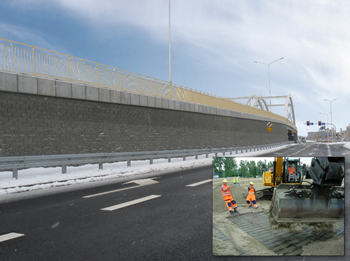 |
Tensartech TW1 structural and retaining walls are being installed in a new raised dual carriageway to bypass the historic City of Wroclaw in South East Poland. The road will give access to the new Miejski Stadium in time for its role in the UEFA Euro 2012 football finals.
Wroclaw Municipality and its main contractor, Skanska, chose the Tensar solution for the 5km bypass project because of its low material costs and rapid construction, as well as its aesthetic appearance and versatility in adapting to site requirements.
Traffic conditions within Wroclaw are frequently very congested due to the narrow streets of the historic centre. It can take two hours or more to transverse the city, located on a major connecting route across Southern Poland.
Started in 2008, the new bypass route is elevated on embankments up to 11 metres high in order to cross the River Oder, the railway and local roads; this will carry through traffic and football fans away from the city centre. A total of 19 separate Tensartech walls were built for the embankment, with 10 incorporated into bridge abutments and flyovers; construction will be completed in 2011.
“Three different techniques were considered for the project,” commented Jacek Kawalec of Tensar International who provided Tensar application advice. “Two involved heavy concrete blocks or large cast concrete panels; both would have been too costly and time consuming to construct, and their appearance would have been unsympathetic to the historic architecture.
“The Tensartech TW1 system is fairly new in Poland, and uses split-face blocks produced locally to Tensar’s exacting standards. In total, the 19 walls of TW1 amounted to 2 km in length, supplemented by around 300 metres of gabion walling; over 12,000m2 of wall in total designed by Drotest.”
The ground over which the embankments were built comprises compacted sands and firm-plastic loams with few load-bearing problems. The locally-sourced mineral aggregate fill was layered with Tensar uniaxial geogrid to form mechanically stabilised soil layers within the embankments, fastened to the dry laid TW1 blocks by Tensar’s unique polymer key.
“Effectively the embankment is a complete self-supporting stable structure, with aggregate to provide the mass and stabilised by the geogrid layers, which connect under tension to the dry laid walls,” adds Jacek Kawalec. “As well as the speed and simplicity of construction, the client and contractors were impressed by the versatility of the design and its visual aesthetics.
“A Tensartech retaining wall is easily constructed with curves to match the road bends. The design can be quickly adapted to meet local requirements and access to embedded services like gas and water is simple, with quick repair. The embankment is load bearing immediately, without waiting for any concrete curing time, so that construction of the road sub-base, asphalt layers, parapet etc follow immediately as the project progresses.”
Investor/Client: WROCLAW Municipality
Contractor: SKANSKA S.A., Wroclaw Branch Office
Main Designer: BIPROGEOPROJEKT, WroclawSub-Designer: WANECKI, Gliwice
Supporting retaining walls design: DROTEST, Gdansk.Supervisor: LAFRENTZ Polska, Poznan
For more information on Tensar Tensartech technology, please visit www.tensar.co.uk.











